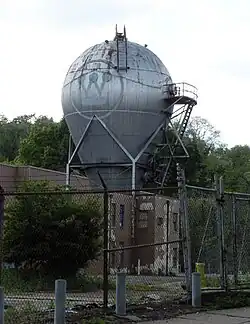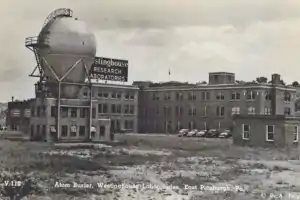Westinghouse Atom Smasher
The Westinghouse Atom Smasher was a 5 million volt Van de Graaff electrostatic nuclear accelerator operated by the Westinghouse Electric Corporation at their Research Laboratories in Forest Hills, Pennsylvania.[1] It was instrumental in the development in practical applications of nuclear science for energy production.[2][3][4] In particular, it was used in 1940 to discover the photofission of uranium and thorium,[5][6] and was most cited for certain nuclear physics measurements.[7] The Westinghouse Atom Smasher was able to make precise measurements of nuclear reactions for the research in nuclear power.[8] It was the first industrial Van de Graaff generator in the world,[9] and marked the beginning of nuclear research for civilian applications.[10][11] Built in 1937, it was a 65-foot-tall (20 m) pear-shaped tower.[9][12] It went dormant in 1958.[12] In 1985, it was named an Electrical Engineering Milestone by the Institute of Electrical and Electronics Engineers.[6]
| Westinghouse Atom Smasher | |
|---|---|
 The Atom Smasher on May 9, 2010, before the 2015 demolition | |
| General information | |
| Address | F Avenue & West |
| Town or city | Forest Hills, Pennsylvania |
| Coordinates | 40.4108661°N 79.8430295°W |
| Opened | 1937 |
| Closed | 1958 |
| Demolished | January 20, 2015 |
| Designated | August 28, 2010 |
History
The Westinghouse Atom Smasher was created due to the interest and development of physics in the early 1900s.[13] In the year 1932, there were some major advancements in the research of nuclear physics. The technology of the particle accelerator has been categorized into three lines of research. The first started with Ernest Rutherford's studies into the properties of atomic particles in the 1920s.[14] Then with John D. Cockroft and Ernest Walton producing the first nuclear disintegrations using artificially accelerated particles.[14] The second line of research was focused on high-energy accelerators and the development of resonant acceleration.[14] The third line of research was the invention of the betatron by Rolf Wideroe in 1923.[14] With the discovery of the nucleus being fresh, much research was being done on how to commercialize it. With the help of particle accelerators, scientists were able to see charged particles and how they are shaped.[15] The use of the particle accelerator allowed scientists to better understand how atoms, atomic nuclei, and nucleons are held together.[15] It also helped scientists learn about quantum physics and how the world works.[15] The Westinghouse atom smasher was the first particle accelerator built to be industrialized.[16] The atom smasher was made to perform the same tasks as the Van de Graaff generator but at a much larger scale with higher voltages.[13] It was used to force atoms to collide with each other at speeds close to the speed of light to create new particles and radiation.[17] These new particles were able to help scientists learn about the basics of matter.[17] The atom smasher remained upright until 1958, but it saw little use after the end of World War II.[18]
How it worked


In a Van de Graaff generator, invented in 1929 by Robert J. Van de Graaff, an endless rubber or fabric belt carries electric charges from a roller at the base of the device and deposits them inside a hollow metal electrode at the top. This causes a high voltage to develop between electrodes at the top and bottom of the apparatus.[19]
In the Westinghouse machine, two high-speed belts traveled up a 47-foot shaft to a mushroom-shaped electrode near the top of the bulb-shaped enclosure, where electric charges were accumulated (see cutaway schematic).[20] Various ions, like those generated from hydrogen gas (protons) or helium gas (alpha particles), were injected into the upper part of an accelerator tube. The high electrostatic potential between the top and bottom of the tube then caused these subatomic particles to accelerate to extremely high velocities as they traveled down a 17-inch-diameter evacuated cylinder 40 feet in height, which was a sealed stack of many individual glass segments that collectively composed the largest vacuum tube in the world at the time of construction.[6] The accelerator tube ran between and parallel to the whirling belts to the base of the machine, where the accelerated particles bombarded experimental targets placed inside the tube, inducing various nuclear reactions.[19][21]
The energy of the particles was measured through the gamma rays that the beam produced when its particles hit a fluorine target, which was directly related to the voltage potential between the machine's electrodes.[21]
The maximum voltage that a Van de Graaff generator can produce is limited by leakage of the charge off the upper electrode due to corona discharge and arcing. At atmospheric pressure, a Van de Graaff machine is generally limited to around 1 megavolt. Thus this instrument was installed inside a pear-shaped 65-foot tall, 30-foot diameter air tank which was pressurized during operation to 120 pounds per square inch.[20] High pressure improved the insulating qualities of the air and reduced charge leakage, allowing the machine to achieve a voltage potential of 5 megavolts. This allowed a beam energy of 5 MeV, although it was originally hoped to reach 10 MeV.
Wartime Efforts
During the second world war, Westinghouse suspended fundamental research efforts, and instead focused on researching microwave radar.[22] This is similar to how M.I.T and Harvard also began their own organizations to study radiation and radio during the war. The atom smasher was shut down so that Westinghouse could focus on the electronics department.[22] Many of the contributors to the Westinghouse project moved onto find other jobs during this period of shut down, but stayed closely connected to the nuclear research that was happening during the time.[22]
Westinghouse's Lamp Division in Bloomfield, NJ began production of uranium metal which was used in the first atomic pile. Prior to becoming Director of Research in the Lamp Division, Harvey Rentschler developed a method of reducing uranium salts into metal to study possible use as a lamp filament. He found that the melting point was too low to be used and decided to shut down the project, until the atomic pile in Chicago began. The only immediate source for uranium metals was the Bloomfield facility. Rentschler was asked to begin production of these metals again for this new project. He started with a crude, low-level production line using galvanized wash tubs as vessels before enlarging the project to further production.[22] E. U. Condon as well as some other atom smasher workers, were sent to work closely on the Manhattan Project to develop uranium isotope separation techniques. The atom smasher itself was used as a compressed air tank for jet engine development during the war.[22]
As the war ended, Westinghouse returned to its normal research activities, bringing back many workers and the refurbished atom smasher. It was found, however, that the iron used for the atom smasher became brittle in low temperatures and the atom smasher may have been damaged during the war. This fact was found when several Liberty ships sailed through the freezing waters of Alaska, their exteriors began to crack and break up, causing the ships to sink due to metal failure.
Preservation efforts
In 2012, the property surrounding the atom smasher was purchased by P&L Investments, LLC.[1] The company was run by Gary Silversmith, a developer who intended to build apartments and expressed an interest in saving the smasher.[23] In 2013, the Young Preservationists Association of Pittsburgh named it as one of the city's top 10 preservation opportunities.[23] During 2013, plans had been discussed of the Woodland Hills School District establishing a STEM educational facility with the atom smasher as the centerpiece, but the $4 to $5 million cost was prohibitive and the project never moved forward.[23]
By 2015, the structure was in significant disrepair and was dislodged from its supports, due to vandalism and age.[23] On January 20, 2015, Silversmith had the atom smasher removed from its supports and laid on its side.[2] Workers laid bricks to brace the fall, and tipped it over.[12] In an email to the Pittsburgh Post-Gazette, Silversmith pronounced his continuing commitment to refurbishing and restoring the atom smasher, saying "The iconic Atom Smasher bulb survives."[23] As of 2023, the atom smasher remains at the demolition site, exposed to the elements.
See also
References
- Walter, Marni Blake (September 1, 2015). "An Unlikely Atomic Landscape: Forest Hills and the Westinghouse Atom Smasher". Western Pennsylvania History Magazine. Senator John Heinz History Center. 98 (3): 36–49. Retrieved December 3, 2019.
- Klein, Barbara (Winter 2016). "Reconstructing Pittsburgh's Atomic Past". Carnegie Magazine. Carnegie Museums of Pittsburgh. 83 (4). Retrieved December 8, 2019.
- "Van de Graaff particle accelerator, Westinghouse Electric and Manufacturing Co., Pittsburgh, PA, August 7, 1945". Explore PA History. WITF-TV. Retrieved February 19, 2015.
- "Westinghouse Electric Corporation [Science and Invention] Historical Marker". Explore PA History. WITF-TV. Retrieved February 19, 2015.
- Haxby, R.O.; Shoupp, W.E.; Stephens, W.E.; Wells, W.H. (January 1, 1941). "Photo-Fission of Uranium and Thorium". Physical Review. 59 (1): 57–62. Bibcode:1941PhRv...59...57H. doi:10.1103/PhysRev.59.57. Retrieved December 3, 2019.
- "Milestones: Westinghouse Atom Smasher, 1937". Engineering and Technology History Wiki. ETHW Partnership. May 29, 1985. Retrieved December 3, 2019.
includes link to 1985 videotape: 'IEEE Milestone Dedication Ceremony'
- Haxby, R.O.; Shoupp, W.E.; Stephens, W.E.; Wells, W.H. (December 15, 1940). "Threshold for the Proton-Neutron Reactions of Lithium, Beryllium, Boron, and Carbon". Physical Review. 58 (12): 1035–1042. Bibcode:1940PhRv...58.1035H. doi:10.1103/PhysRev.58.1035. Retrieved October 2, 2021.
- Coltman, John W. (February 1987). "The Westinghouse Atom Smasher???An IEEE Historical Milestone". IEEE Transactions on Education. E-30 (1): 37–42. doi:10.1109/TE.1987.5570584. S2CID 20864894 – via IEEE.
- "PHMC Historical Markers Search" (Searchable database). Pennsylvania Historical and Museum Commission. Commonwealth of Pennsylvania. Retrieved 2015-02-15.
- Toker, Franklin (2009). Pittsburgh: A New Portrait. p. 470. ISBN 9780822943716.
- Fey, Maury; Dollard, Walt (April 3, 2015). "The Echoes from Westinghouse at Forest Hills / Forest Hills Nuclear History". Atomic Confluence. Retrieved December 7, 2019.
- O'Neill, Brian (January 25, 2015). "Brian O'Neill: With Forest Hills atom smasher's fall, part of history tumbles". Pittsburgh Post-Gazette.
- Coltman, John W. (February 1987). "The Westinghouse Atom Smasher???An IEEE Historical Milestone". IEEE Transactions on Education. E-30 (1): 37–39. doi:10.1109/TE.1987.5570584. S2CID 20864894 – via IEEE.
- "Particle accelerators". ETHW. 2014-04-28. Retrieved 2023-04-14.
- "DOE Explains...Particle Accelerators". Energy.gov. Retrieved 2023-04-14.
- "Historic Westinghouse Atom Smasher Fate Unclear - Nuclear Museum". ahf.nuclearmuseum.org/. 2023-03-24. Retrieved 2023-03-24.
- Tanya Lewis (2013-08-12). "Incredible Technology: How Atom Smashers Work". livescience.com. Retrieved 2023-03-17.
- Cheney, Jim (2022-01-02). "The Amazing Story of the Abandoned Westinghouse Atom Smasher in Pittsburgh". Uncovering PA. Retrieved 2023-03-24.
- "Mightiest Atom Smasher At East Pittsburgh, PA". Life. Vol. 3, no. 9. August 30, 1937. pp. 36–39. Retrieved December 14, 2019.
- "Huge generator to smash atoms". Popular Science. 131 (1): 35. July 1937. Retrieved April 28, 2015.
- Chubb, L.W. (November 1941). "Giving Atoms the Third Degree". Popular Mechanics. 76 (5): 8–11. Retrieved December 14, 2019.
- Coltman, John (1987). "The Westinghouse Atom Smasher-An IEEE Historical Milestone". IEEE Transactions on Education. E-30 (1): 40. doi:10.1109/TE.1987.5570584. S2CID 20864894.
- Harkins, Jill (January 21, 2015). "Atom smasher in Forest Hills torn down; restoration promised". Pittsburgh Post-Gazette.
External links
 Media related to Westinghouse Atom Smasher at Wikimedia Commons
Media related to Westinghouse Atom Smasher at Wikimedia Commons
